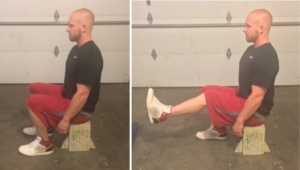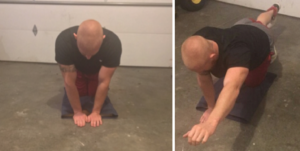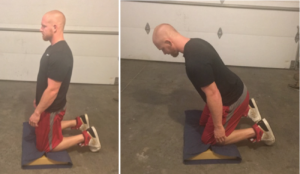How many of you utilize half kneeling with the individuals you work with? Now how many of you always give that same person a weight of some sort to load them in half kneeling? If your hand is still raised then the rest of this is for you. I have one question I want you to ponder while you read, how do you load someone without weight? That is what I am going to attempt to answer.
A few months back Dr. Mark Cheng did a workshop that left me an many others with the very question I asked you. Since the workshop I have taken some of his ideas, experimented on myself as well as the patients that I see. What I want to talk about is internally loading someone, quite simply an internal load is a stress placed on the body by changing the individuals sensory input or perception, no outside tools are used. Right here is where I got stuck after my weekend with Dr. Cheng and didn’t know how to effectively load someone internally, aside from giving them an external load and challenging their strength or cardiovascular system. This is partly because I am fortunate enough to work in a facility that has nearly all the strength training amenities you could ask for and am well versed in implementing them all into my rehabilitation so that is where I continuously tried to go with loading. This method which works great while your patients or clients are there with you, but what about when they aren’t. What do you send someone in pain with as homework? My answer definitely isn’t an unsupervised weighted exercise. The other side of this story is that the majority of my patients are either young kids 10-15 or adults 30’s and up, very few move like a college athlete. So why wouldn’t I want to externally load these individuals?
As for the kids their attention span is shorter than mine which means handing them a weight isn’t always the best idea and when it comes to the adults chances are they have had the pain for months or years and their movement patterns are significantly limited, which makes it hard to externally load them at times safely. Learning to internally load individuals, especially adults, gives them more freedom to help manage their pain and the independence they need. There are plenty of ways to internally load someone but I am going to go over the basics that I use daily. When I say challenge it needs to be manageable but difficult, if they fail repeatedly you it must be modified until they can adequately control it. The purpose of internally loading someone is to get them to reflexively stabilize just their own body, nothing else. If you control your body better you control weights better.
Internal Loading Options:
- Challenge their vestibular system
- Challenge their visual system
- Challenge their proprioception
- Challenge their posture
The first three are all components of balance and easily manipulated. The final point is how you can really challenge someone’s stability. To do so you must first correct their poor alignment and force them to keep the proper position, this is easily done by giving them a specific task to achieve with little excess movement allowed.
Now a few examples of how I accomplish each, I should note that one of my favorite things to do is make people realize just how hard controlling their own body can be.
- Challenge their vestibular system
- This is easily done by having them tilt their head to the side or look at the ceiling
- Change their perception of where they are spatially
- Challenge their visual system
- You can obviously close their eyes, or combine this and the first one and have them look around the room
- I play “I Spy” regularly
- Challenge their proprioception
- This can be done a number of ways but the easiest is to change to a narrow or smaller base of support
- You can also shift their center of mass around their base of support
- Challenge their posture
- To do this you can correct their posture with some assistance and then have them stay there but you need to have them hold long enough to expose their weaknesses and compensations
- I also like to correct their posture and then make them move around that stable base paying close attention to what parts want to move that shouldn’t be needing to
If you’re still reading this try these simple exercises and see what you think.
- While sitting on a box in slight hip flexion try to stay tall while lifting and straightening out one leg. Performing a few reps on each leg will gas most people’s CNS quickly when forced to pay attention to their postural alignment.

- Get into the old “bird dog” pose but try it by starting with your knees touching one another and your hands lined up under your manubrium. This one really exposes limitations and takes advantage of changing your proprioception.

- Next, try to do a proper hip hinge out of tall kneeling with your knees nearly touching and see if you find a point you almost fall forward. This works the vestibular system and changes proprioception.

- Finally my favorite one is to get into the top of a lunge with your feet pointed straight ahead, and see how close to in-line you can get them without falling. The real challenge comes when you look over each shoulder slowly. This exercise really hits all of the internal loading strategies.




Leave a Reply